Driver Emotion and Fatigue State Detection Based on Time Series Fusion
Abstract
1. Introduction
- (1)
- Firstly, the established multi-feature dual-threshold fatigue detection model incorporates fatigue metrics, such as head posture, fatigue eye closure frequency, eye closure duration, yawn frequency, etc., and shows superior performance compared with several classical fatigue detection algorithms;
- (2)
- Secondly, the improved lightweight RM-Xception convolutional neural network model for emotion recognition, which performs well in expression feature extraction capability, achieving an accuracy of 73.32% on the Fer2013 expression dataset;
- (3)
- Thirdly, the method proposed in this paper combines driver fatigue and emotional state for the first time, based on time series fusion metrics, which more accurately and comprehensively reflects the driver state.
2. Related Work
2.1. Fatigue Detection Methods
2.2. Emotion Recognition Methods
3. Materials and Methods
3.1. Image Pre-Processing and Face Detection
3.1.1. Image Pre-Processing
3.1.2. Face and Key Point Detection
3.2. Multi-Feature Double-Threshold Fatigue Recognition Algorithm
3.2.1. Key Features Selection
3.2.2. Double-Threshold Fatigue Index Calculation
3.2.3. Fatigue Recognition Algorithm with Multi-Feature Fusion
3.3. Improved RM-Xception Emotion Recognition Algorithm
3.3.1. Convolutional Neural Network
3.3.2. Improved RM-Xception Emotion Recognition Algorithm
3.4. Time Series-Based Emotional Fatigue Feature Fusion Algorithm
4. Results
4.1. Experimental Platform and Dataset
4.2. Fatigue Detection Experiment
4.3. Emotion Recognition Experiment
4.4. Driver Status Detection Experiment
5. Conclusions
Author Contributions
Funding
Institutional Review Board Statement
Informed Consent Statement
Data Availability Statement
Conflicts of Interest
References
- World Health Organization. Global Status Report on Road Safety 2018: Summary; Technical Report; World Health Organization: Geneva, Switzerland, 2018.
- Alvaro, P.K.; Burnett, N.M.; Kennedy, G.A.; Min, W.Y.X.; McMahon, M.; Barnes, M.; Jackson, M.; Howard, M.E. Driver education: Enhancing knowledge of sleep, fatigue and risky behaviour to improve decision making in young drivers. Accid. Anal. Prev. 2018, 112, 77–83. [Google Scholar] [CrossRef] [PubMed]
- Li, G.; Lai, W.; Sui, X.; Li, X.; Qu, X.; Zhang, T.; Li, Y. Influence of traffic congestion on driver behavior in post-congestion driving. Accid. Anal. Prev. 2020, 141, 105508. [Google Scholar] [CrossRef] [PubMed]
- Eon, M. Towards affect-integrated driving behavior research. Theor. Issues Ergon. Sci. 2015, 16, 553–585. [Google Scholar]
- Lee, Y.C. Measuring drivers’ frustration in a driving simulator. In Proceedings of the Human Factors and Ergonomics Society Annual Meeting; Sage Publications: Los Angeles, CA, USA, 2010; Volume 54. [Google Scholar]
- Koh, S.; Cho, B.R.; Lee, J.; Kwon, S.-O.; Lee, S.; Lim, J.B.; Lee, S.B.; Kweon, H.-D. Driver drowsiness detection via PPG biosignals by using multimodal head support. In Proceedings of the 2017 4th International Conference on Control, Decision and Information Technologies (CoDIT), Barcelona, Spain, 5–7 April 2017; pp. 383–388. [Google Scholar]
- Kulathumani, A.; Soua, R.; Karray, F.; Kamel, M.S. Recent trends in driver safety monitoring systems: State of the art and challenges. IEEE Trans. Veh. Technol. 2017, 66, 4550–4563. [Google Scholar]
- Balandong, R.P.; Ahmad, R.F.; Saad, M.N.M.; Malik, A.S. A review on EEG-based automatic sleepiness detection systems for driver. IEEE Access 2018, 6, 2290822919. [Google Scholar] [CrossRef]
- Rohit, F.; Kulathumani, V.; Kavi, R.; Elwarfalli, I.; Kecojevic, V.; Nimbarte, A. Real-time drowsiness detection using wearable, lightweight brain sensing headbands. IET Intell. Transp. Syst. 2017, 11, 255–263. [Google Scholar] [CrossRef]
- Sheykhivand, S.; Rezaii, T.Y.; Mousavi, Z.; Meshgini, S.; Makouei, S.; Farzamnia, A.; Danishvar, S.; Teo Tze Kin, K. Automatic Detection of Driver Fatigue Based on EEG Signals Using a Developed Deep Neural Network. Electronics 2022, 11, 2169. [Google Scholar] [CrossRef]
- Chai, R.; Naik, G.R.; Nguyen, T.N.; Ling, S.H.; Tran, Y.; Craig, A.; Nguyen, H.T. Driver fatigue classification with independent component by entropy rate bound minimization analysis in an EEG-based system. IEEE J. Biomed. Health Inform. 2017, 21, 715–724. [Google Scholar] [CrossRef]
- Mohan, K.; Seal, A.; Krejcar, O.; Yazidi, A. Facial Expression Recognition Using Local Gravitational Force Descriptor-Based Deep Convolution Neural Networks. IEEE Trans. Instrum. Meas. 2020, 70, 5003512. [Google Scholar] [CrossRef]
- Minaee, S.; Minaei, M.; Abdolrashidi, A. Deep-emotion: Facial expression recognition using the attentional convolutional network. Sensors 2021, 21, 3046. [Google Scholar] [CrossRef]
- Xiao, H.; Li, W.; Zeng, G.; Wu, Y.; Xue, J.; Zhang, J.; Li, C.; Guo, G. On-Road Driver Emotion Recognition Using Facial Expression. Appl. Sci. 2022, 12, 807. [Google Scholar] [CrossRef]
- Chen, J.; Yan, M.; Zhu, F.; Xu, J.; Li, H.; Sun, X. Fatigue Driving Detection Method Based on Combination of BP Neural Network and Time Cumulative Effect. Sensors 2022, 22, 4717. [Google Scholar] [CrossRef] [PubMed]
- Braun, M.; Chadowitz, R.; Alt, F. User Experience of Driver State Visualizations: A Look at Demographics and Personalities. In Proceedings of the IFIP Conference on Human-Computer Interaction, Paphos, Cyprus, 2–6 September 2019; Springer: Cham, Switzerland, 2019; pp. 158–176. [Google Scholar]
- Yu, J.; Park, S.; Lee, S.; Jeon, M. Representation Learning, Scene Understanding, and Feature Fusion for Drowsiness Detection. In Computer Vision—Accv 2016 Workshops, Pt Iii.; Chen, C.S., Lu, J., Ma, K.K., Eds.; Springer International Publishing Ag: Cham, Switzerland, 2017; Volume 10118, pp. 165–177. [Google Scholar]
- Li, S.; Zheng, W.; Zong, Y.; Lu, C.; Tang, C.; Jiang, X.; Liu, J.; Xia, W. Bi-modality Fusion for Emotion Recognition in the Wild. In Proceedings of the 2019 International Conference on Multimodal Interaction Icmi’19, Suzhou, China, 14–18 October 2019; Assoc Computing Machinery: New York, NY, USA, 2019; pp. 589–594. [Google Scholar]
- Li, F.; Wang, X.W.; Lu, B.L. Detection of Driving Fatigue Based on Grip Force on Steering Wheel with Wavelet Transformation and Support Vector Machine. In ICONIP 2013: Neural Information Processing; Lecture Notes in Computer Science; Springer: Berlin/Heidelberg, Germany, 2013; Volume 8228. [Google Scholar]
- Zhang, L.; Yang, D.; Ni, H.; Yu, T. Driver Fatigue Detection Based on SVM and Steering Wheel Angle Characteristics. In Proceedings of the 19th Asia Pacific Automotive Engineering Conference & SAE-China Congress 2017: Selected Papers, Shanghai, China, 24–26 October 2017; Lecture Notes in Electrical Engineering. Springer: Singapore, 2017; Volume 486, pp. 729–738. [Google Scholar]
- Lin, C.T.; Chen, Y.C.; Huang, T.Y.; Chiu, T.T.; Ko, L.W.; Liang, S.F.; Hsieh, H.Y.; Hsu, S.H.; Duann, J.R. Development of Wireless Brain Computer Interface with Embedded Multitask Scheduling and its Application on Real-time Driver’s Drowsiness Detection and Warning. IEEE Trans. Bio-Med. Eng. 2008, 55, 1582–1591. [Google Scholar] [CrossRef]
- Zhu, T.; Zhang, C.; Wu, T.; Ouyang, Z.; Li, H.; Na, X.; Liang, J.; Li, W. Research on a Real-Time Driver Fatigue Detection Algorithm Based on Facial Video Sequences. Appl. Sci. 2022, 12, 2224. [Google Scholar] [CrossRef]
- He, H.; Zhang, X.; Jiang, F.; Wang, C.; Yang, Y.; Liu, W.; Peng, J. A Real-time Driver Fatigue Detection Method Based on Two-Stage Convolutional Neural Network. IFAC-PapersOnLine 2020, 53, 15374–15379. [Google Scholar] [CrossRef]
- Fang, B.; Xu, S.; Feng, X. A Fatigue Driving Detection Method Based on Multi Facial Features Fusion. In Proceedings of the 2019 11th International Conference on Measuring Technology and Mechatronics Automation (ICMTMA), Qiqihar, China, 28–29 April 2019; pp. 225–229. [Google Scholar]
- Li, K.; Gong, Y.; Ren, Z. A Fatigue Driving Detection Algorithm Based on Facial Multi-Feature Fusion. IEEE Access 2020, 8, 101244–101259. [Google Scholar] [CrossRef]
- Jenke, R.; Peer, A.; Buss, M. Feature Extraction and Selection for Emotion Recognition from EEG. IEEE Trans. Affect. Comput. 2014, 5, 327–339. [Google Scholar] [CrossRef]
- Perdiz, J.; Pires, G.; Nunes, U.J. Emotional State Detection Based on EMG and EOG Biosignals: A Short Survey. In Proceedings of the 2017 IEEE 5th Portuguese Meeting on Bioengineering (Enbeng), Coimbra, Portugal, 16–18 February 2017. [Google Scholar]
- Panda, R.; Malheiro, R.; Paiva, R.P. Novel Audio Features for Music Emotion Recognition. IEEE Trans. Affect. Comput. 2020, 11, 614–626. [Google Scholar] [CrossRef]
- Kun, H.; Yu, D.; Tashev, I. Speech emotion recognition using deep neural network and extreme learning machine. In Proceedings of the Fifteenth Annual Conference of the International Speech Communication Association, Singapore, 14–18 September 2014. [Google Scholar]
- Kansizoglou, I.; Misirlis, E.; Tsintotas, K.; Gasteratos, A. Continuous Emotion Recognition for Long-Term Behavior Modeling through Recurrent Neural Networks. Technologies 2022, 10, 59. [Google Scholar] [CrossRef]
- Xu, L.; Ren, X.; Chen, R. Fatigue driving detection based on eye state recognition. Sci. Technol. Eng. 2020, 20, 8292–8299. [Google Scholar]
- Shang, L.; Shi, Q.; Fang, J. Eye detection and fatigue judgment based on OpenCV. Electron. World 2018, 23, 19–20. [Google Scholar]
- Sun, W.; Zhang, X.; Wang, J.; He, J.; Peeta, S. Blink number forecasting based on improved bayesian fusion algorithm for fatigue driving detection. Math. Probl. Eng. 2015, 1, 832621. [Google Scholar] [CrossRef]
- Ekman, P.; Friesen, W.V. Facial Action Coding System(FACS): A technique for the measurement of facial actions. Riv. Di Psichiatr. 1978, 47, 126–138. [Google Scholar]
- Abtahi, S.; Omidyeganeh, M.; Shirmohammadi, S.; Hariri, B. YawDD: A yawning detection dataset. In Proceedings of the 5th ACM Multimedia Systems Conference, Singapore, 19–21 March 2014; ACM: New York, NY, USA; pp. 24–28. [Google Scholar]



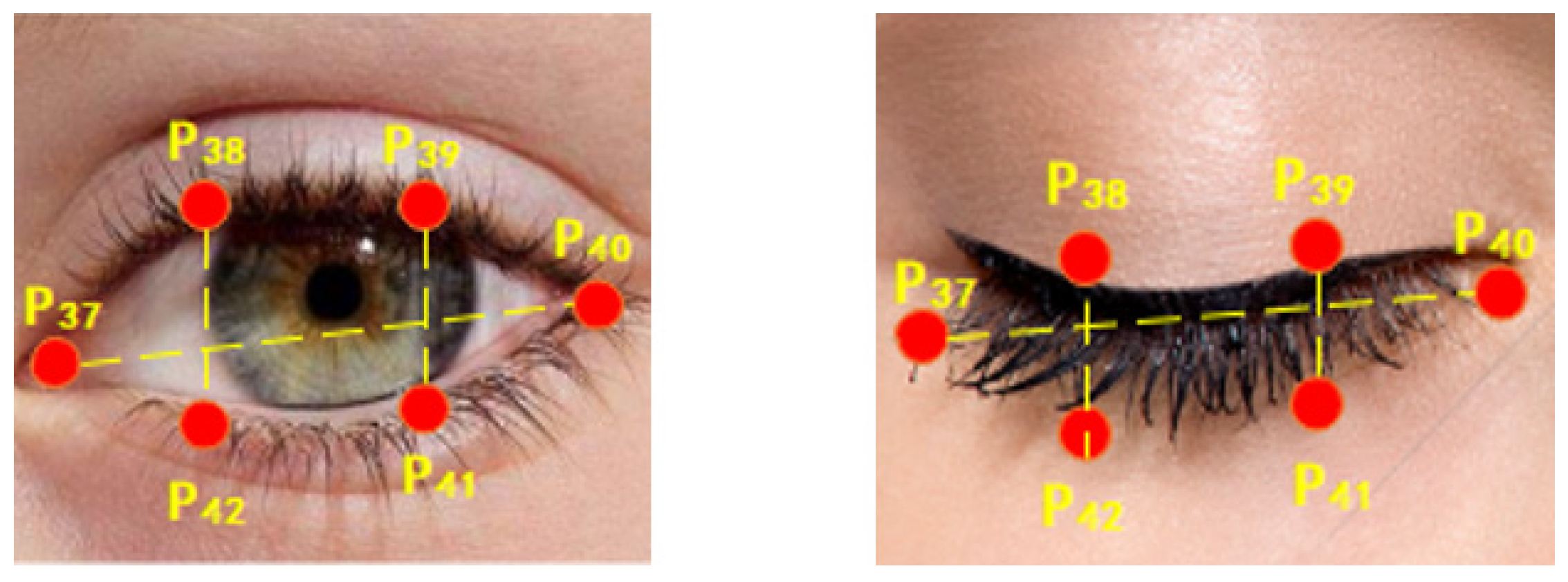
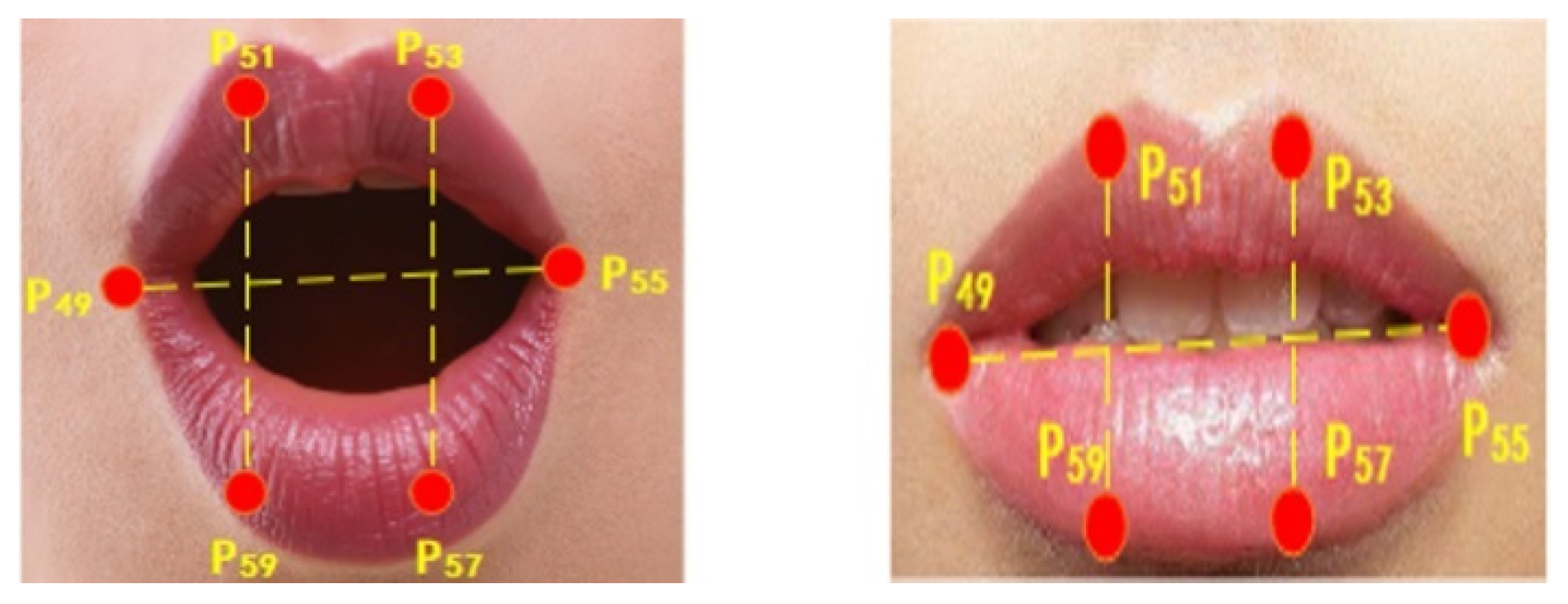
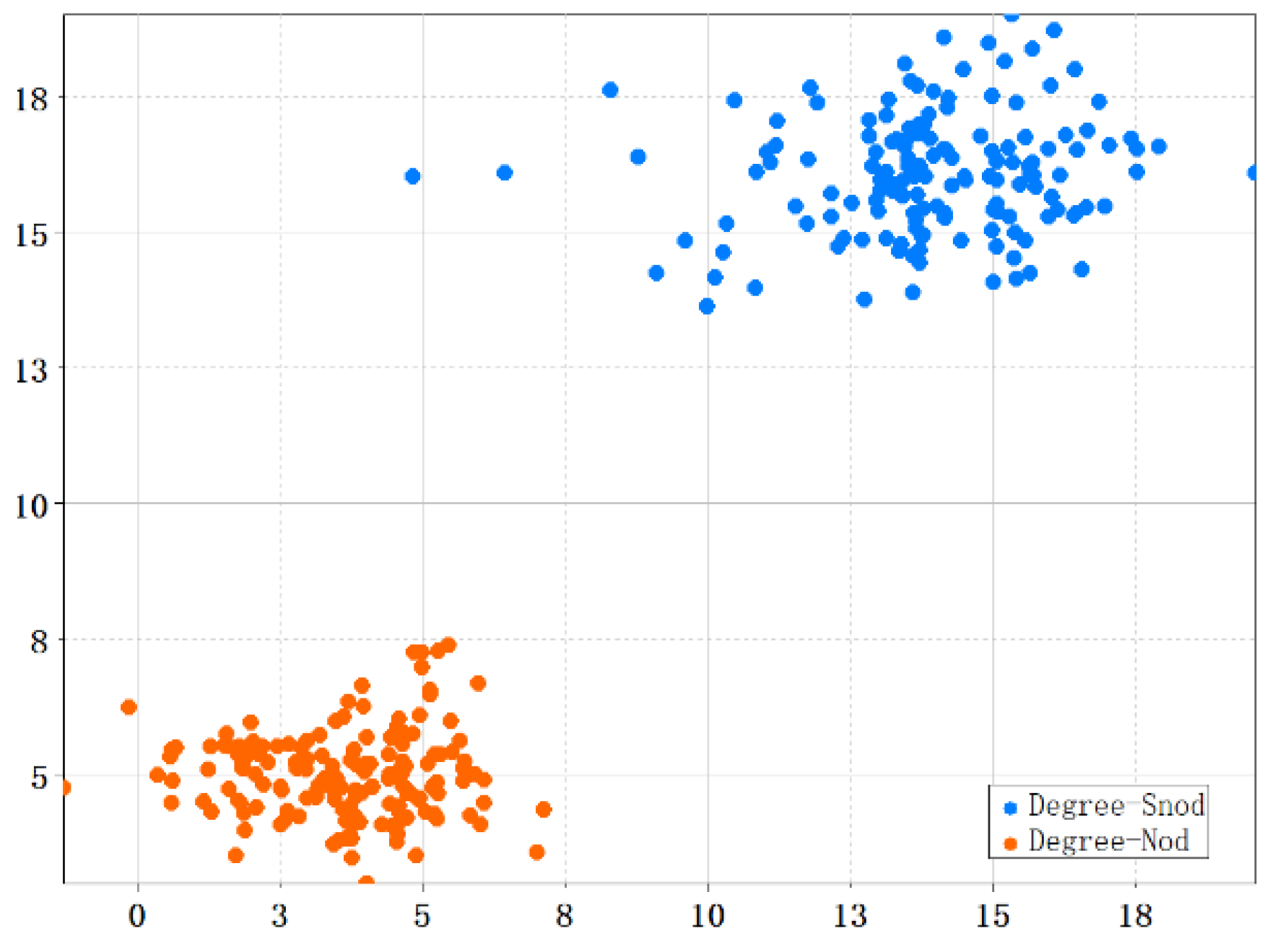





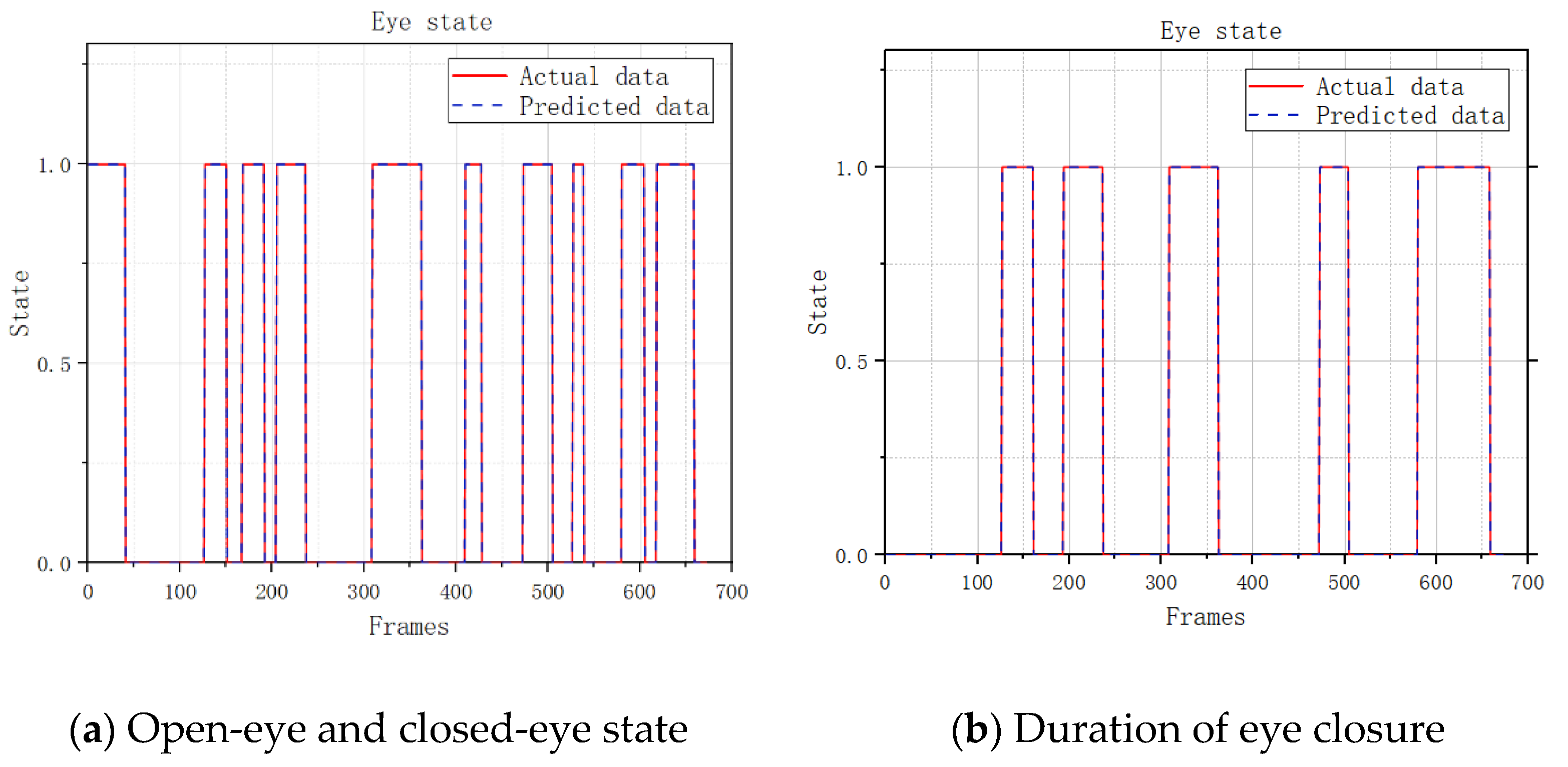
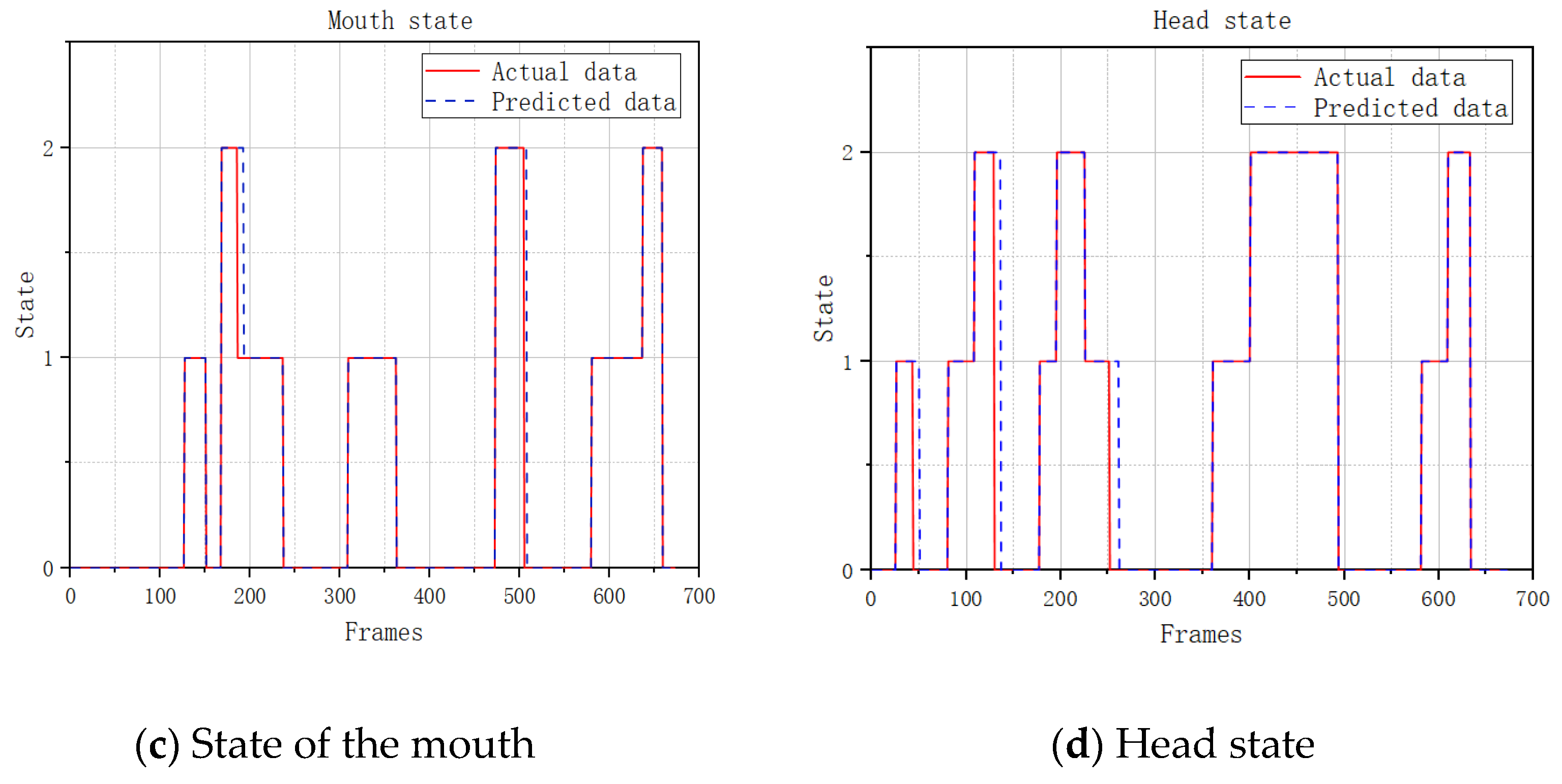

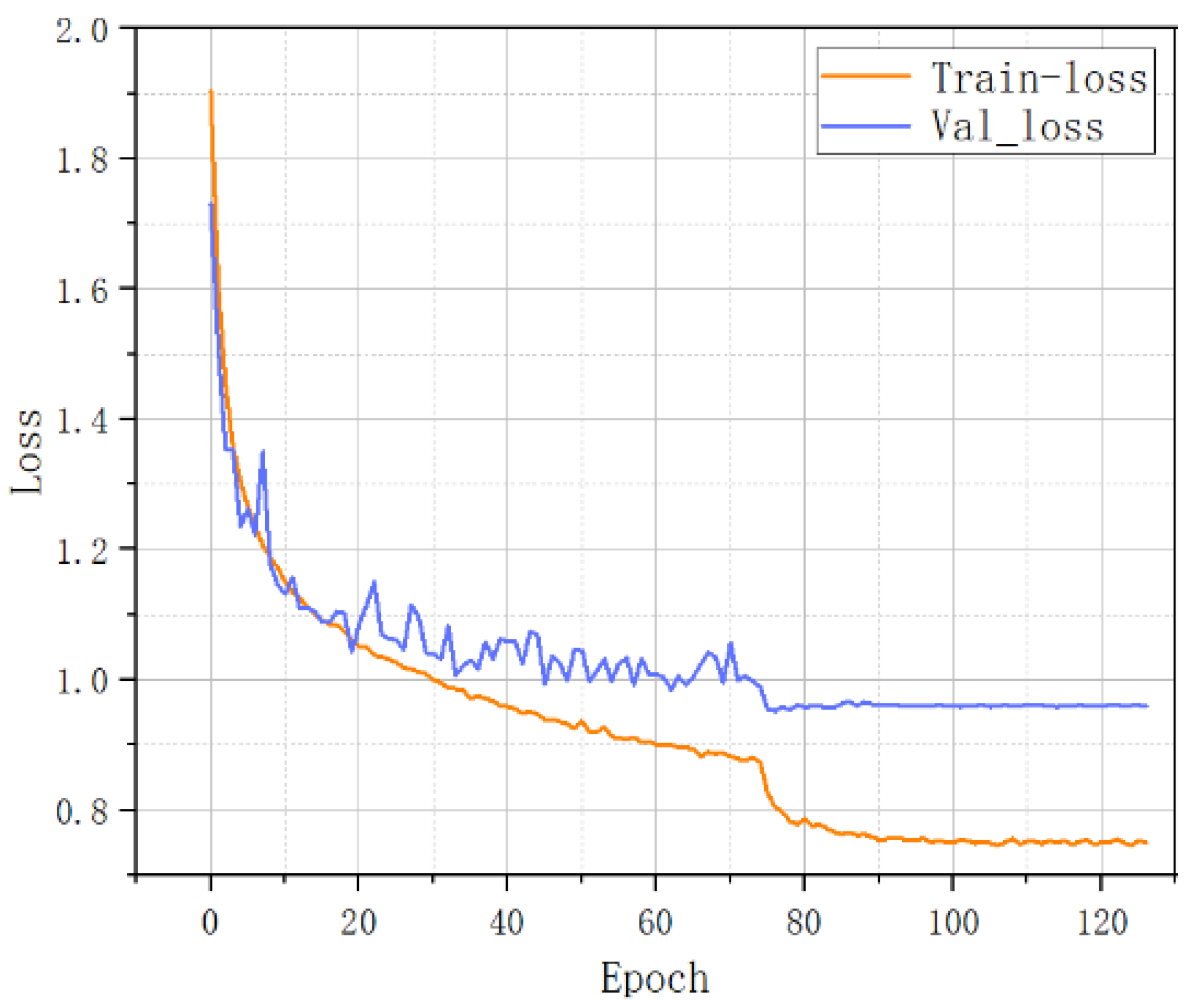
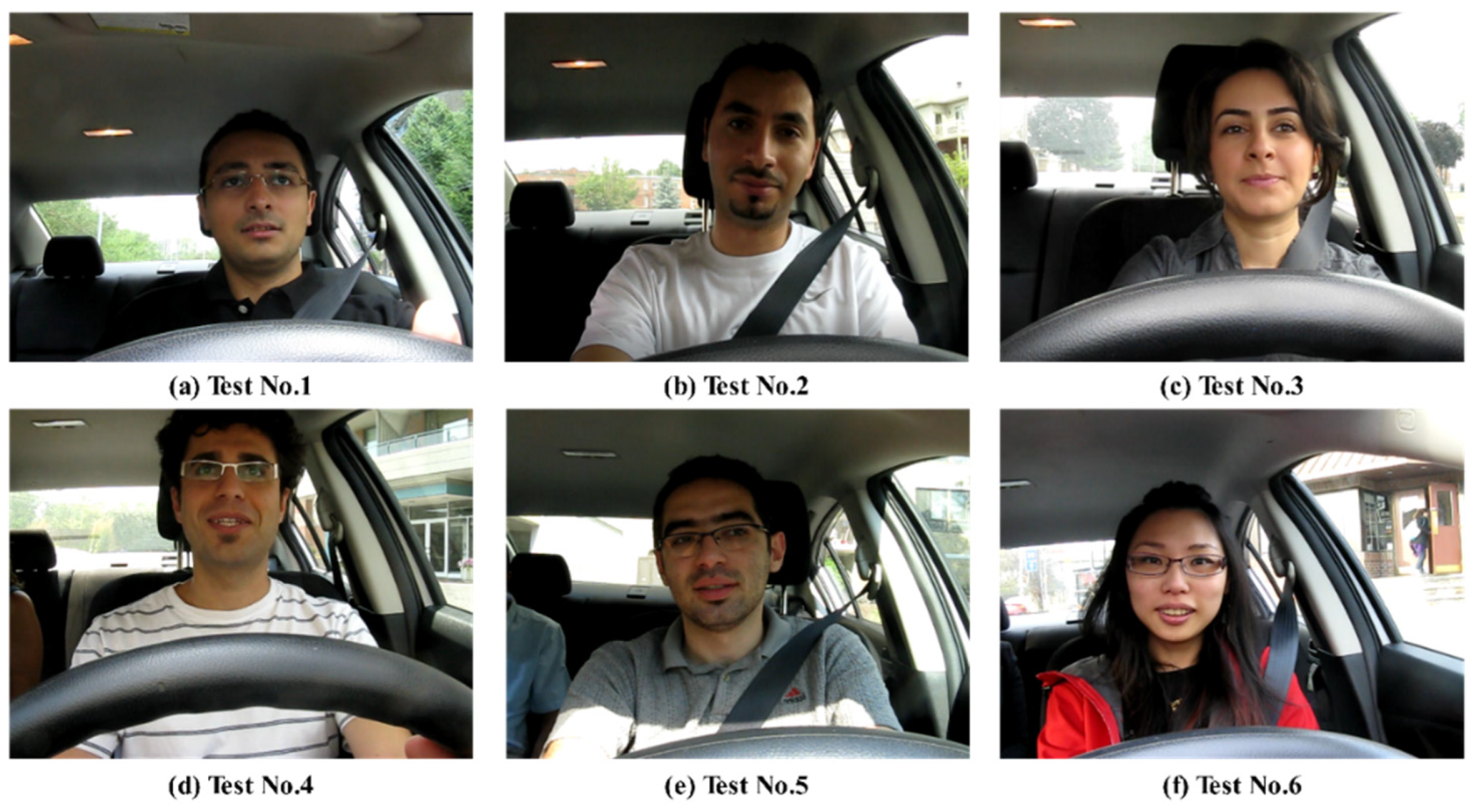
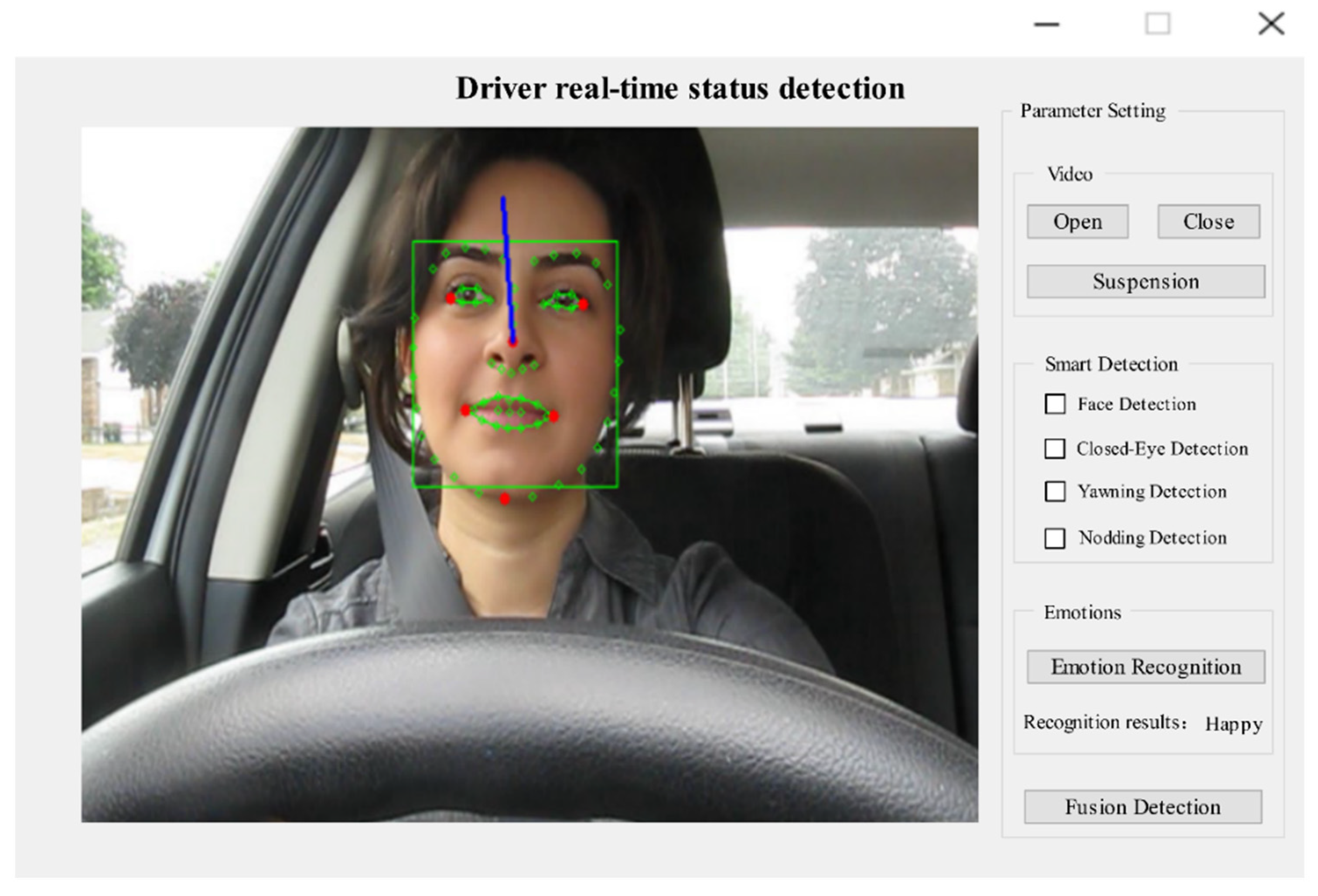
| Fatigue Indicators | Value | Normalization |
|---|---|---|
| Frequency of eye closure for fatigue | Fblink/(Times · S−1) | F′blink |
| Yawning frequency | FYawn/(Times · S−1) | F′Yawn |
| Sleepy nod frequency | FNod/(Times · S−1) | F′Nod |
| PERCLOS | P / % | P′ |
| Real-Time Emotions | Score | Real-Time Emotions | Score |
|---|---|---|---|
| Happy | −0.001 | Anger | 0.002 |
| Neutral | 0.000 | Sadness | 0.002 |
| Disgust | 0.001 | Fear | 0.003 |
| Surprise | 0.001 |
| S Takes the Value of | Status Level | Fatigue Behavioral Manifestations | Advance Warning Measures |
|---|---|---|---|
| <0.01 | Suitable for driving | Driver mood and fatigue indicators are normal | None |
| 0.01~0.02 | Lower risk | Individual indicators began to increase | Intermittent alerts |
| 0.02~0.03 | Higher risks | Indicators with higher scores emerged | Increased alarm frequency |
| >0.03 | Unsuitable for driving | Fatigue or mood scores near maximum, or both at moderate to high levels | Continuous alerts |
| Test Number | Number of Actual Blinks (Times/min) | Detects the Number of Blink Counts (Times/min) | Accuracy (%) | The Actual Number of Eye Closures (Times/min) | Detects the Number of Eye Closures (Times/min) | Accuracy (%) |
|---|---|---|---|---|---|---|
| 1 | 9 | 9 | 100% | 1 | 1 | 100% |
| 2 | 20 | 21 | 95.2% | 4 | 4 | 100% |
| 3 | 15 | 15 | 100% | 2 | 2 | 100% |
| 4 | 19 | 19 | 100% | 1 | 1 | 100% |
| 5 | 23 | 23 | 100% | 5 | 5 | 100% |
| Test Number | Number of Actual Yawning (Times/min) | Detect the Number of Yawning (Times/min) | Accuracy (%) |
|---|---|---|---|
| 1 | 2 | 2 | 100% |
| 2 | 4 | 4 | 100% |
| 3 | 1 | 1 | 100% |
| 4 | 3 | 3 | 100% |
| 5 | 2 | 2 | 100% |
| Test Number | Number of Eye Closures for Fatigue (Times/min) | Number of Yawning (Times/min) | Number of Drowsy Nods (Times/min) | PERC LOS/% | Fatigue Composite Index |
|---|---|---|---|---|---|
| 1 | 1 | 4 | 0 | 0.0119 | 0.0128 |
| 2 | 5 | 2 | 4 | 0.0241 | 0.0283 |
| 3 | 4 | 12 | 0 | 0.0250 | 0.0424 |
| 4 | 3 | 9 | 1 | 0.0198 | 0.0331 |
| 5 | 4 | 15 | 4 | 0.0308 | 0.0501 |
| Algorithm | Accuracy/% |
|---|---|
| Xception | 66.80 |
| CNN | 65.00 |
| Inception V4 | 67.01 |
| The algorithm in this paper | 73.32 |
| Test Number | Fatigue Eyes Closed Times | Yawning Times | Number of Drowsy Nods | PERC LOS/% | Fatigue Comprehensive Indicators | Emotions Score | Comprehensive Status Indicators | Predicted Driving States | Actual Driving Condition |
|---|---|---|---|---|---|---|---|---|---|
| 1 | 2 | 3 | 0 | 1.36 | 0.015 | 0.000 | 0.008 | Suitable for driving | Suitable for driving |
| 2 | 4 | 1 | 4 | 4.53 | 0.031 | 0.003 | 0.017 | Lower risk | Lower risk |
| 3 | 2 | 2 | 0 | 2.35 | 0.016 | −0.009 | 0.004 | Suitable for driving | Suitable for driving |
| 4 | 1 | 13 | 0 | 1.92 | 0.029 | 0.000 | 0.015 | Lower risk | Lower risk |
| 5 | 4 | 7 | 0 | 2.98 | 0.031 | 0.005 | 0.018 | Lower risk | Lower risk |
| 6 | 8 | 6 | 0 | 3.21 | 0.041 | 0.021 | 0.031 | Unsuitable for driving | Unsuitable for driving |
Disclaimer/Publisher’s Note: The statements, opinions and data contained in all publications are solely those of the individual author(s) and contributor(s) and not of MDPI and/or the editor(s). MDPI and/or the editor(s) disclaim responsibility for any injury to people or property resulting from any ideas, methods, instructions or products referred to in the content. |
© 2022 by the authors. Licensee MDPI, Basel, Switzerland. This article is an open access article distributed under the terms and conditions of the Creative Commons Attribution (CC BY) license (https://creativecommons.org/licenses/by/4.0/).
Share and Cite
Shang, Y.; Yang, M.; Cui, J.; Cui, L.; Huang, Z.; Li, X. Driver Emotion and Fatigue State Detection Based on Time Series Fusion. Electronics 2023, 12, 26. https://doi.org/10.3390/electronics12010026
Shang Y, Yang M, Cui J, Cui L, Huang Z, Li X. Driver Emotion and Fatigue State Detection Based on Time Series Fusion. Electronics. 2023; 12(1):26. https://doi.org/10.3390/electronics12010026
Chicago/Turabian StyleShang, Yucheng, Mutian Yang, Jianwei Cui, Linwei Cui, Zizheng Huang, and Xiang Li. 2023. "Driver Emotion and Fatigue State Detection Based on Time Series Fusion" Electronics 12, no. 1: 26. https://doi.org/10.3390/electronics12010026
APA StyleShang, Y., Yang, M., Cui, J., Cui, L., Huang, Z., & Li, X. (2023). Driver Emotion and Fatigue State Detection Based on Time Series Fusion. Electronics, 12(1), 26. https://doi.org/10.3390/electronics12010026








